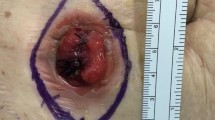Abstract
Wounds following stoma closures are at a high risk of infection due to the presence of the intestinal flora. Hence a wound breakdown after a primary stoma closure is common. In anticipation of such a surgical site infection, stoma closure wounds can be treated with antimicrobial agents while allowing the wound to heal with a secondary intention. While most skin antiseptics have similar efficacies, silver dressing has the advantage of patient convenience with its less frequent need of dressing change.
Similar content being viewed by others
References
Harold DM, Johnson EK, Rizzo JA, Steele SR (2010) Primary closure of stoma site wounds after ostomy takedown. Am J Surg 199:621–624
Van de Pavoordt H, Fazio V, Jagelman D (1987) The outcome of loop ileostomy closure in 293 cases. Int J Colorect 2:214–217
Hackam DJ, Rotstein OD (1995) Stoma closure and wound infection: an evaluation of risk factors. Can J Surg 38:144–148
Jones SA, Bower PG, Walker M, Parsons D (2004) Controlling wound bioburden with a novel silver-containing Hydrofiber dressing. Wound Repair Regen 12:288–294
Vanscheidt W, Lazareth I, Routkovsky-Norval C (2003) Safety evaluation of a new ionic silver dressing in the management of chronic ulcers. Wounds 15(11):371–378
Coutts P, Sibbald RG (2005) The effect of a silver-containing Hydrofiber dressing on superficial wound bed and bacterial balance of chronic wounds. Int Wound J 2:348–356
Mangram AJ, Horan TC, Pearson ML, Silver LC, Jarvis WR (1999) Hospital Infection Control Practices Advisory Committee. Guideline for prevention of surgical site infection. American journal of infection control. 30;27(2):97–134
Phang P, Hain J, Perez-Ramirez J (1999) Techniques and complications of ileostomy takedown. Am J Surg 177:463–466
Berry DP, Scholefield JH (1997) Closure of loop ileostomy. Br J Surg 84(4):524
Wong KS, Remzi FH, Gorgun E, Arrigain S, Church JM, Preen M, Fazio VW (2005) Loop ileostomy closure after restorative proctocolectomy: outcome in 1,504 patients. Dis Colon Rectum 48:243–250
Benarjee A (1997) Purse-string skin closure after stoma reversal. Dis Colon Rectum 40:993–994
Klink CD et al (2013) Influence of skin closure technique on surgical site infection after loop ileostomy reversal: retrospective cohort study. Int J Surg 11:1123–1125
Suh YJ, Park JW, Kim YS, Park SC, JH O (2014) A beneficial effect of purse-string skin closure after ileostomy takedown: a retrospective cohort study. Int J Surg 12(6):615–620
Lee JR, Kim YW, Sung JJ, Song OP, Kim HC, Lim CW, Cho GS, Jung JC, Shin EJ (2011) Conventional linear versus purse-string skin closure after loop ileostomy reversal: comparison of wound infection rates and operative outcomes. J Korean Soc Coloproctol 27(2):58–63
Zubaidah NH, Soo JY, Qisti N, Ong KW, Gee T (2016) Wound infection following stoma reversal: a prospective comparative study between primary closure and partial closure with intervening silver dressings. Int J Colorectal Dis 31(7):1381–1382
Ovington LG (2001) Hanging wet to dry dressings out to dry. Home Healthc Nurse 19:477–483
White RJ (2001) New developments in the use of dressings on surgical wounds. Br J Nurs 10(6 suppl):S70
Leaper DJ (2006) Silver dressings: their role in wound management. Int Wound J 3:282–294
White RJ (2001) An historical overview of the use of silver in wound management. Br J Nurs 10(suppl):3–8
Ip M, Sau LL, Poon VKM, Lung I, Burd A (2006) Antimicrobial activities of silver dressings: an in vitro comparison. J Med Microbiol 55:59–63
Fraser JF, Bodman J, Sturgess R, Faoagali J, Kimble RM (2004) An in vitro study of the anti-microbial efficacy of a 1% silver sulphadiazine and 0.2% chlorhexidine digluconate cream, 1% silver sulphadiazine cream and a silver coated dressing. Burns 30:35–41
Carter MJ, Tingley-Kelley K, Warriner RA (2010) Silver treatments and silver- impregnated dressings for the healing of leg wounds and ulcers: a systematic review and meta-analysis. J Am Acad Dermatol 63(4):668–679
Funding
Research grant from University Putra Malaysia.
Conflict of Interest None.
Author information
Authors and Affiliations
Corresponding author
Editor information
Editors and Affiliations
Rights and permissions
Copyright information
© 2017 Springer International Publishing AG
About this chapter
Cite this chapter
Hanipah, Z.N., Ying, S.J., Fathi, N.Q., Wah, O.K., Gee, T. (2017). Wound Infection Following Stoma Reversal: A Prospective Comparative Study. In: Shiffman, M., Low, M. (eds) Burns, Infections and Wound Management. Recent Clinical Techniques, Results, and Research in Wounds, vol 2. Springer, Cham. https://doi.org/10.1007/15695_2017_37
Download citation
DOI: https://doi.org/10.1007/15695_2017_37
Published:
Publisher Name: Springer, Cham
Print ISBN: 978-3-030-10685-0
Online ISBN: 978-3-030-10686-7
eBook Packages: MedicineMedicine (R0)




